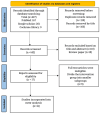Telemedicine and Gestational Diabetes Mellitus: Systematic Review and Meta-Analysis
- PMID: 39564055
- PMCID: PMC11574696
- DOI: 10.7759/cureus.71907
Telemedicine and Gestational Diabetes Mellitus: Systematic Review and Meta-Analysis
Abstract
Hyperglycemia known as gestational diabetes mellitus (GDM) can happen during pregnancy and poses a risk to the developing baby as well as the mother. Glycemic control, patient involvement, and diabetes management might all be improved via telemedicine (TM). Therefore, this study aimed to compare TM versus standard care for GDM in terms of maternal and fetal outcomes. The authors searched for randomized controlled trials (RCTs) contrasting TM with conventional care among gestational diabetes women across various databases including PubMed, the Cochrane Central Register of Controlled Studies, and Google Scholar from April 2010 to December 2023. This meta-analysis included a total of 2,192 pregnant women from 12 RCT studies and was analyzed by RevMan (version 5.4; Cochrane, London). Applying fixed and random effects was based on heterogeneity. There was a statistically significant difference in the effect on the control of blood glucose levels two-hour postprandial (MD = -0.45, 95%CI = (-0.84, -0.06), P = 0.02) and on the cesarean section effect (RR = 0.74, 95%CI = (0.63, 0.87), P < 0.001) when TM was compared to standard care for GDM. However, there was no statistically significant difference in the effect on other maternal or fetal outcomes such as HBA1c, fasting blood glucose, preterm birth, fetal macrosomia, or hypoglycemia. TM interventions are more successful than standard therapy in lowering the rate of cesarean section and decreasing the two-hour postprandial glucose level of GDM patients, which is essential for improving glycemic control and reducing cardiovascular disease.
Keywords: fetal outcomes; gestational diabetes mellitus; maternal outcomes; randomized controlled trials; telemedicine.
Copyright © 2024, El Seifi et al.
Conflict of interest statement
Conflicts of interest: In compliance with the ICMJE uniform disclosure form, all authors declare the following: Payment/services info: All authors have declared that no financial support was received from any organization for the submitted work. Financial relationships: All authors have declared that they have no financial relationships at present or within the previous three years with any organizations that might have an interest in the submitted work. Other relationships: All authors have declared that there are no other relationships or activities that could appear to have influenced the submitted work.
Figures








References
-
- IDF Diabetes Atlas: Estimation of global and regional gestational diabetes mellitus prevalence for 2021 by International Association of diabetes in pregnancy study group’s criteria. Wang H, Li N, Chivese T, et al. Diabetes Res Clin Pract. 2022;183:109050. - PubMed
-
- Gestational diabetes mellitus. McIntyre HD, Catalano P, Zhang C, Desoye G, Mathiesen ER, Damm P. Nat Rev Dis Primers. 2019;5:47. - PubMed
Publication types
LinkOut - more resources
Full Text Sources
Miscellaneous
